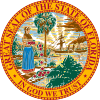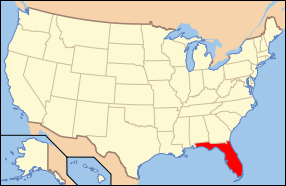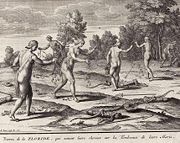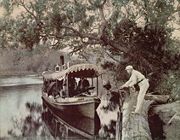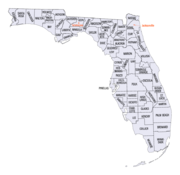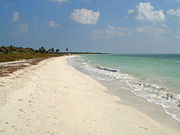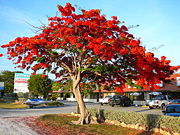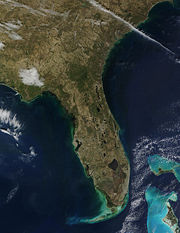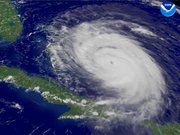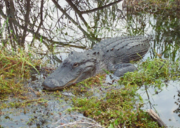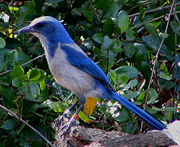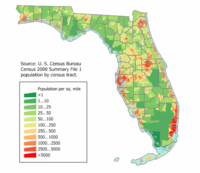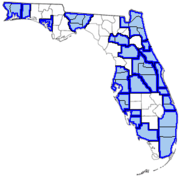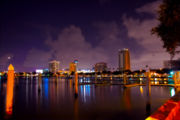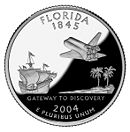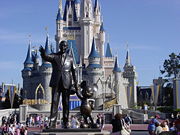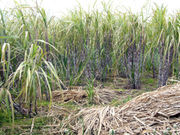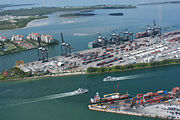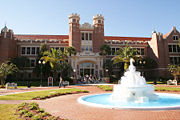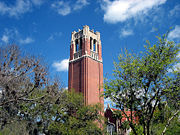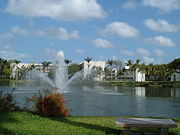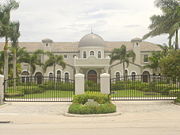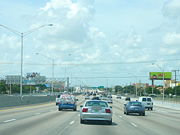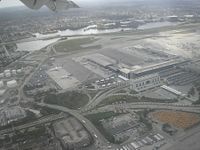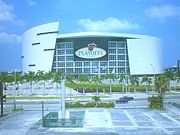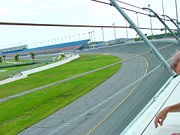Florida
2008/9 Schools Wikipedia Selection. Related subjects: North American Geography
| State of Florida | |||||||||||
|
|||||||||||
| Official language(s) | English | ||||||||||
| Demonym | Floridian | ||||||||||
| Capital | Tallahassee | ||||||||||
| Largest city | Jacksonville | ||||||||||
| Largest metro area | Miami | ||||||||||
| Area | Ranked 22nd in the US | ||||||||||
| - Total | 65,795 sq mi (170,304 km²) |
||||||||||
| - Width | 361 miles (582 km) | ||||||||||
| - Length | 447 miles (721 km) | ||||||||||
| - % water | 17.9 | ||||||||||
| - Latitude | 24°27′ N to 31° N | ||||||||||
| - Longitude | 80°02′ W to 87°38′ W | ||||||||||
| Population | Ranked 4th in the US | ||||||||||
| - Total | 15,982,378 (18.25 million as of 2007) | ||||||||||
| - Density | 309/sq mi 117.3/km² (8th in the US) |
||||||||||
| - Median income | $41,171 (36th) | ||||||||||
| Elevation | |||||||||||
| - Highest point | Britton Hill 345 ft (105 m) |
||||||||||
| - Mean | 98 ft (30 m) | ||||||||||
| - Lowest point | Atlantic Ocean 0 ft (0 m) |
||||||||||
| Admission to Union | March 3, 1845 (27th) | ||||||||||
| Governor | Charlie Crist (R) | ||||||||||
| Lieutenant Governor | Jeff Kottkamp (R) | ||||||||||
| U.S. Senators | Bill Nelson (D) Mel Martinez (R) |
||||||||||
| Congressional Delegation | List | ||||||||||
| Time zones | |||||||||||
| - peninsula | Eastern: UTC-5/ DST-4 | ||||||||||
| - panhandle | Central: UTC-6/DST-5 | ||||||||||
| Abbreviations | FL Fla. US-FL | ||||||||||
| Website | www.myflorida.com | ||||||||||
| Florida State Symbols | |
|---|---|
| Living symbols | |
| - Bird | Mockingbird |
| - Butterfly | Zebra Longwing |
| - Fish | Florida largemouth bass, Atlantic sailfish |
| - Flower | Orange blossom |
| - Insect | Zebra Longwing |
| - Mammal | Florida panther, Manatee, Bottle-nosed dolphin |
| - Reptile | American Alligator |
| - Tree | Sabal Palmetto |
| Beverage | Orange juice |
| Food | Key lime pie, Orange |
| Fossil | agatized Coral |
| Gemstone | Moonstone |
| Rock | agatized Coral |
| Shell | Horse conch |
| Slogan(s) | Visit Florida |
| Soil | Myakka |
| Song(s) | Old Folks at Home (Way Down Upon The Swanee River) |
| Route marker(s) |
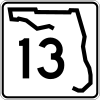 |
| Quarter |
 2004 |
| See also | |
Florida (IPA: /ˈflɒrɪdə/) is a state located in the southeastern region of the United States, bordering Alabama to the northwest and Georgia to the northeast. Much of the land mass of the state is a large peninsula with the Gulf of Mexico to the west and the Atlantic Ocean to the east. Most of Florida has a humid subtropical climate; southern Florida has a tropical climate. Florida was named by Juan Ponce de León, who landed on the peninsula on 2 April 1513, during Pascua Florida (Spanish for "Flowery Easter," referring to the Easter season). Florida is the fourth most populous state in the U.S.
History
Archaeological research indicates that Florida had been inhabited for thousands of years before any European settlements. Of the many indigenous peoples, the largest known were the Ais, the Apalachee, the Calusa, the Timucua and the Tocobago tribes. Juan Ponce de León, a Spanish conquistador, named Florida in honour of his discovery of the land on April 2, 1513, during Pascua Florida, a Spanish term for the Easter season (Juan Ponce de León may not have been the first European to reach Florida; according to one report, at least one indigenous tribesman who he encountered in Florida in 1513 spoke Spanish.). From that date forward, the land became known as "La Florida" , although from 1630 until the 19th century Tegesta (after the Tequesta tribe) was the name of choice for the Florida peninsula following publication of a map by the Dutch cartographer Hessel Gerritsz in Joannes de Laet's History of the New World.
Over the following century, both the Spanish and French established settlements in Florida, with varying degrees of success. In 1559, Spanish Pensacola was established by Don Tristán de Luna y Arellano as the first European settlement in the continental United States, but it had become abandoned by 1561 and would not be reinhabited until the 1690s. French Huguenots founded Fort Caroline in modern-day Jacksonville in 1564, but the fort was conquered by forces from the new Spanish colony of St. Augustine the following year. After Huguenot leader Jean Ribault had learned of the new Spanish threat, he launched an expedition to sack the Spanish settlement; en route, however, severe storms at sea waylaid the expedition, which consisted of most of the colony's men, allowing St. Augustine founder Pedro Menéndez de Avilés time to march his men over land and conquer Fort Caroline. Most of the Huguenots were slaughtered, and Menéndez de Avilés marched south and captured the survivors of the wrecked French fleet, ordering all but a few Catholics executed beside a river subsequently called Matanzas (Spanish for 'killings'). The Spanish never had a firm hold on Florida, and maintained tenuous control over the region by converting the local tribes, briefly with Jesuits and later with Franciscan friars. The local leaders ( caciques) demonstrated their loyalty to the Spanish by converting to Roman Catholicism and welcoming the Franciscan priests into their villages.
The area of Spanish Florida diminished with the establishment of English colonies to the north and French colonies to the west. The English weakened Spanish power in the area by supplying their Creek Indian allies with firearms and urging them to raid the Timucuan and Apalachee client-tribes of the Spanish. The English attacked St. Augustine, burning the city and its cathedral to the ground several times, while the citizens hid behind the walls of the Castillo de San Marcos.
The Spanish, meanwhile, encouraged slaves to flee the English-held Carolinas and come to Florida, where they were converted to Roman Catholicism and given freedom. They settled in a buffer community north of St. Augustine, called Gracia Real de Santa Teresa de Mose, the first completely black settlement in what would become the United States.
Great Britain gained control of Florida diplomatically in 1763 through the Peace of Paris. The British divided the colony into East Florida, with its capital at St. Augustine, and West Florida, with its capital at Pensacola. Britain tried to develop the Floridas through the importation of immigrants for labor, including some from Minorca and Greece, but this project ultimately failed. Spain regained the Floridas after Britain's defeat by the American colonies and the subsequent Treaty of Versailles in 1783, continuing the division into East and West Florida. They offered land grants to anyone who settled in the colonies, and many Americans moved to them.
After settler attacks on Indian towns, Seminole Indians based in East Florida began raiding Georgia settlements, purportedly at the behest of the Spanish. The United States Army led increasingly frequent incursions into Spanish territory, including the 1817 – 1818 campaign against the Seminole Indians by Andrew Jackson that became known as the First Seminole War. Following the war, the United States effectively controlled East Florida. In 1819, by terms of the Adams-Onís Treaty, Spain ceded Florida to the United States in exchange for the American renunciation of any claims on Texas and $5 million.
As settlement increased, pressure grew on the United States government to remove the Indians from their lands in Florida. To the chagrin of Georgia landowners, the Seminoles harbored and integrated runaway blacks, and clashes between whites and Indians grew with the influx of new settlers. In 1832, the United States government signed the Treaty of Payne's Landing with some of the Seminole chiefs, promising them lands west of the Mississippi River if they agreed to leave Florida voluntarily. Many of the Seminoles left at this time, while those who remained prepared to defend their claims to the land. White settlers pressured the government to remove all of the Indians, by force if necessary, and in 1835, the U.S. Army arrived to enforce the treaty.
The Second Seminole War began at the end of 1835 with the Dade Massacre, when Seminoles ambushed Army troops marching from Fort Brooke (Tampa) to reinforce Fort King (Ocala), killing or mortally wounding all but one of the 108 troops. Between 900 and 1,500 Seminole Indian warriors effectively employed hit and run guerrilla tactics against United States Army troops for seven years. Osceola, a charismatic young war leader, came to symbolize the war and the Seminoles after he was arrested at truce negotiations in 1837 and died in prison less than a year later. The war dragged on until 1842. The U.S. government is estimated to have spent between US$20 million and US$40 million on the war, at the time an astronomical sum. Even after three bloody wars, the U.S. failed to force all of the Seminole Indians in Florida to the West. Though most of the Seminoles were forcibly exiled to Creek lands west of the Mississippi, hundreds, including Seminole leader Aripeka (Sam Jones), remained in the Everglades and refused to leave the native homeland of their ancestors. Their descendants remain there to this day.
On March 3, 1845, Florida became the 27th state of the United States of America. Its population grew slowly. White settlers continued to encroach on lands used by the Seminoles, and the United States government resolved to make another effort to move the remaining Seminoles to the West. The Third Seminole War lasted from 1855 to 1858, and resulted in the removal of most of the remaining Seminoles. White settlers began to establish cotton plantations in Florida, which required numerous laborers. By 1860 Florida had only 140,424 people, of whom 44% were enslaved. There were fewer than 1000 free people of colour before the Civil War.
On January 10, 1861, before the formal outbreak of the Civil War, Florida seceded from the Union; ten days later, the state became a founding member of the Confederate States of America. The war ended in 1865. On June 25, 1868, Florida's congressional representation was restored. After Reconstruction, white Democrats succeeded in regaining power in the state legislature. In 1885 they created a new constitution, followed by statutes through 1889 that effectively disfranchised most blacks and many poor whites over the next several years. Provisions included poll taxes, literacy tests, and residency requirements. Disfranchisement for most African Americans in the state persisted until the Civil Rights Movement of the 1960s gained federal legislation to protect their suffrage.
Until the mid-twentieth century, Florida was the least populous Southern state. In 1900 its population was only 528,542, of whom nearly 44 percent were African American. The boll weevil devastated cotton crops, and early 20th century lynchings and racial violence caused a record number of African Americans to leave the state in the Great Migration to northern and midwestern industrial cities. Forty thousand blacks, roughly one-fifth of their 1900 population, left for better opportunities. National economic prosperity in the 1920s stimulated tourism to Florida. Combined with its sudden elevation in profile was the Florida land boom of the 1920s, which brought a brief period of intenseland development. The stock market crash and Great Depression brought that period to a halt.
Florida's economy did not fully recover until the buildup for World War II. The climate, tempered by the growing availability of air conditioning, and low cost of living made the state a haven. Migration from the Rust Belt and the Northeast sharply increased the population after the war. In recent decades, more migrants have come for the jobs in a developing economy. Today, with an estimated population of more than 18 million, Florida is the most populous state in the Southeastern United States, the second most populous state in the South behind Texas, and the fourth most populous in the United States. The Census Bureau estimates that "Florida, now the fourth most populous state, would edge past New York into third place in total population by 2011".
Geography
Much of the state of Florida is situated on a peninsula between the Gulf of Mexico, the Atlantic Ocean, and the Straits of Florida. It extends to the northwest into a panhandle, extending along the northern Gulf of Mexico. It is bordered on the north by the states of Georgia and Alabama, and on the west, at the end of the panhandle, by Alabama. It is near several Caribbean countries, particularly the Bahamas and Cuba. Florida's extensive coastline made it a perceived target during World War II, so the government built airstrips throughout the state; today, approximately 400 airports are still in service. According to the National Drug Intelligence Centre, Florida has 131 public airports, and more than 700 private airports, airstrips, heliports, and seaplane bases. Florida is one of the largest states east of the Mississippi River, and only Alaska and Michigan are larger in water area.
The Florida peninsula is a porous plateau of karst limestone sitting atop bedrock. Extended systems of underwater caves, sinkholes and springs are found throughout the state and supply most of the water used by residents. The limestone is topped with sandy soils deposited as ancient beaches over millions of years as global sea levels rose and fell. During the last Ice Age, lower sea levels and a drier climate revealed a much wider peninsula, largely desert. The Everglades, an enormously wide, very slow-flowing river encompasses the southern tip of the peninsula.
Because Florida is not located near any tectonic plate boundaries, earthquakes are very rare, but not totally unknown. In January, 1879, a shock occurred near St. Augustine, Florida. There were reports of heavy shaking that knocked plaster from walls and articles from shelves. Similar effects were noted at Daytona Beach, Florida 50 miles (80 km) south. The tremor was felt as far south as Tampa and as far north as Savannah, Georgia. In January 1880, Cuba was the centre of two strong earthquakes that sent severe shock waves through the city of Key West, Florida. Another earthquake centered outside Florida was the great Charleston, South Carolina earthquake of 1886. The shock was felt throughout northern Florida, ringing church bells at St. Augustine and severely jolting other towns along that section of Florida's east coast. Jacksonville residents felt many of the strong aftershocks that occurred in September, October, and November 1886. As recently as 2006, a magnitude 6.0 earthquake centered about 260 miles (420 km) southwest of Tampa in the Gulf of Mexico sent shock waves through southwest and central Florida. The earthquake was too small to trigger a tsunami and no damage was reported.
At 345 feet (105 m) above mean sea level, Britton Hill is the highest point in Florida and the lowest highpoint of any U.S. state. Much of the state south of Orlando is low-lying and fairly level; however, some places, such as Clearwater, feature vistas that rise 50 to 100 feet (15 – 30 m) above the water. Much of Central and North Florida, typically 25 miles (40 km) or more away from the coastline, features rolling hills with elevations ranging from 100 to 250 feet (30 – 76 m). The highest point in peninsular Florida, Sugarloaf Mountain, is a 312-foot (95 m) peak in Lake County.
Areas under control of the National Park Service include:
- Big Cypress National Preserve, near Lake Okeechobee
- Biscayne National Park, in Miami-Dade County south of Miami
- Canaveral National Seashore, near Titusville
- Castillo de San Marcos National Monument, in St. Augustine
- De Soto National Memorial, in Bradenton
- Dry Tortugas National Park, at Key West
- Everglades National Park in Southern Florida
- Fort Caroline National Memorial, at Jacksonville
- Fort Matanzas National Monument, in St. Augustine
- Gulf Islands National Seashore, near Gulf Breeze
- Timucuan Ecological and Historic Preserve, in Jacksonville
Areas under the control of the USDA United States Forest Service include:
- Apalachicola National Forest along the east bank of the Apalachicola River,
- Choctawhatchee National Forest near Niceville,
- Ocala National Forest in Central Florida, and
- Osceola National Forest in Northeast Florida.
Boundaries
The state line begins in the Atlantic Ocean, traveling west, south, and north up the thalweg of the Saint Mary's River. At the origin of that river, it then follows a straight line nearly due west and slightly north, to the point where the confluence of the Flint River (from Georgia) and the Chattahoochee River (down the Alabama/Georgia line) used to form Florida's Apalachicola River. (Since Woodruff Dam was built, this point has been under Lake Seminole.) The border with Georgia continues north through the lake for a short distance up the former thalweg of the Chattahoochee, then with Alabama runs due west along latitude 31°N to the Perdido River, then south along its thalweg to the Gulf via Perdido Bay. Much of the state is at or near sea level.
Climate
The climate of Florida is tempered somewhat by its proximity to water. The state has a humid subtropical climate, except for the southern part below Lake Okeechobee, which has a true tropical climate. Cold fronts can occasionally bring high winds and cool to cold temperatures to the entire state during late fall and winter. One such front swept through the peninsula on November 25, 1996, bringing cold temperatures and winds up to 95 miles per hour (150 km/h), knocking out power to thousands and damaging mobile homes. The seasons in Florida are actually determined more by precipitation than by temperature with mild to cool, relatively dry winters and autumns (the dry season) and hot, wet springs and summers (the wet season). The Gulf Stream has a moderating effect on the climate, and although much of Florida commonly sees a high summer temperature over 90 degrees Fahrenheit (32 °C), the mercury seldom exceeds 100 degrees Fahrenheit (38 °C). The hottest temperature ever recorded in the state was 109 °F (43 °C), set on June 29, 1931 in Monticello. The coldest was – 2 °F (−19 °C), on February 13, 1899, just 25 miles (40 km) away, in Tallahassee. Mean high temperatures for late July are primarily in the low 90s Fahrenheit (32 – 35 °C). Mean low temperatures for late January range from the low 40s Fahrenheit (4 – 7 °C) in northern Florida to the mid-50s (≈13 °C) in southern Florida.
The Florida Keys, surrounded by water, have a tropical climate with lesser variability in temperatures. At Key West, temperatures rarely exceed 90 °F (32 °C) in the summer or fall below 60 °F (16 °C) in the winter, and frost has never been reported in the Keys.
Florida's nickname is the "Sunshine State", but severe weather is a common occurrence in the state. Central Florida is known as the lightning capital of the United States, as it experiences more lightning strikes than anywhere else in the country. Florida has the highest average precipitation of any state, in large part because afternoon thunderstorms are common in most of the state from late spring until early autumn. A fair day may be interrupted with a storm, only to return to sunshine. These thunderstorms, caused by collisions between airflow from the Gulf of Mexico and airflow from the Atlantic Ocean, pop up in the early afternoon and can bring heavy downpours, high winds, and sometimes tornadoes. Florida leads the United States in tornadoes per square mile (when including waterspouts) but these tornadoes do not typically reach the intensity of those in the Midwest and Great Plains. Hail often accompanies the most severe thunderstorms.
Snow in Florida is a rare occurrence. During the Great Blizzard of 1899, Florida experienced blizzard conditions; the Tampa Bay area had "gulf-effect" snow, similar to lake-effect snow. The Great Blizzard of 1899 is the only time the temperature in the state is known to have fallen below 0 degrees Fahrenheit (−18 °C). The most widespread snowfall in Florida history happened on 19 January 1977, when snow fell over much of the state, as far south as Homestead. Snow flurries fell on Miami Beach for the only time in recorded history. A hard freeze in 2003 brought "ocean-effect" snow flurries to the Atlantic coast as far south as Cape Canaveral.
The 1993 Superstorm brought blizzard conditions to the panhandle, while heavy rain and tornadoes beset the peninsula. The storm is believed to have been similar in composition to a hurricane, and even brought storm surges of six feet or more to regions of the Gulf coast.
Although some storms have formed out of season, tropical cyclones pose a severe threat during hurricane season, which lasts from June 1 to November 30. Florida is the most hurricane-prone US state, with subtropical or tropical water on three sides and a lengthy coastline. It is rare for a hurricane season to pass without any impact in the state by at least a tropical storm. August to October is the most likely period for a hurricane in Florida.
In 2004, Florida was hit by a record four hurricanes. Hurricanes Charley ( August 13), Frances ( September 4 – 5), Ivan ( September 16), and Jeanne ( September 25 – 26) cumulatively cost the state's economy US$42 billion. In 2005, Hurricane Dennis ( July 10) became the fifth storm to strike Florida within eleven months. Later, Hurricane Katrina ( August 25) passed through South Florida and Hurricane Rita ( September 20) swept through the Florida Keys. Hurricane Wilma made landfall in Florida in the early morning of October 24 as a Category 3 hurricane, with the storm's eye hitting near Cape Romano, just south of Marco Island, according to the National Hurricane Centre.
Florida was the site of the second costliest weather disaster in U.S. history, Hurricane Andrew, which caused more than US$25 billion in damage when it struck on August 24, 1992. In a long list of other infamous hurricane strikes are the 1926 Great Miami Hurricane, the 1928 Okeechobee Hurricane, the Labor Day Hurricane of 1935, Hurricane Donna in 1960, and Hurricane Opal in 1995. Recent research suggests the storms are part of a natural cycle and not a result of Global Warming.
| Monthly Normal High and Low Temperatures For Various Florida Cities | ||||||||||||
| City | Jan | Feb | Mar | Apr | May | Jun | Jul | Aug | Sep | Oct | Nov | Dec |
|---|---|---|---|---|---|---|---|---|---|---|---|---|
| Jacksonville | 65/43 | 68/45 | 74/50 | 80/56 | 86/64 | 90/70 | 92/73 | 91/73 | 87/70 | 80/61 | 73/51 | 66/44 |
| Key West | 75/65 | 76/66 | 79/69 | 82/72 | 85/76 | 88/78 | 89/80 | 90/80 | 88/78 | 85/76 | 80/71 | 76/67 |
| Melbourne | 72/51 | 73/53 | 77/57 | 81/61 | 85/67 | 88/71 | 90/73 | 90/73 | 88/72 | 83/67 | 78/60 | 73/53 |
| Miami | 76/60 | 77/61 | 80/64 | 83/68 | 86/72 | 88/75 | 90/77 | 90/77 | 88/76 | 85/72 | 81/67 | 77/62 |
| Pensacola | 61/43 | 64/46 | 70/51 | 76/58 | 84/66 | 89/72 | 90/74 | 90/74 | 87/70 | 80/60 | 70/50 | 63/45 |
| Tallahassee | 64/40 | 67/42 | 73/48 | 80/53 | 87/62 | 91/69 | 91/72 | 91/72 | 88/68 | 81/57 | 72/47 | 66/41 |
| Tampa | 71/51 | 72/52 | 77/57 | 82/62 | 88/68 | 90/73 | 90/75 | 90/75 | 89/73 | 84/66 | 77/58 | 72/52 |
Fauna
Florida is host to many types of wildlife including:
- Marine Mammals: Bottlenose Dolphin, Pilot Whale, Northern Right Whale, Manatee
- Reptiles: Alligator, Crocodile, Eastern Diamondback and Pygmy Rattlesnakes, Gopher Tortoise, Green & Leatherback Sea Turtles, Indigo Snake
- Mammals: Panther, Whitetail Deer, Key Deer, Bobcats, Southern Black Bear, Armadillos
- Birds: Bald Eagle, Crested Caracara, Snail Kite, Osprey, Pelicans, Sea Gulls, Whooping & Sandhill Cranes, Roseate Spoonbill, Florida Scrub Jay (State endemic), and many more. Note : Florida is a winter home for most species of eastern North American birds.
Since their accidental importation from South America into North America in the 1930s, the Red imported fire ant population has increased its territorial range to include most of the Southern United States, including Florida. They are more aggressive than most native ant species and have a painful sting.
Environmental issues
Florida ranks forty-fifth in total energy consumption per capita, despite the heavy reliance on air conditioners and pool pumps. This includes coal, natural gas, petroleum, and retail electricity sales. It is estimated that approximately 4% of energy in the state is generated through renewable resources. Florida's energy production is 6 percent of the nation's total energy output, while total production of pollutants is lower, with figures of 5.6 percent for nitrogen oxide, 5.1 percent for carbon dioxide, and 3.5 percent for sulfur dioxide.
It is believed that significant energy resources are located off of Florida's western coast in the Gulf of Mexico, but that region has been closed to exploration since 1981. Governor Charlie Crist and both of Florida's U.S. Senators, Bill Nelson and Mel Martinez, oppose offshore drilling and exploration. Former Governor Jeb Bush, who was originally opposed to all drilling, changed his position in 2005 when he supported a bill introduced into the House of Representatives which allowed unrestricted drilling 125 miles (201 km) or more from the coast. Crist, Martinez and Nelson opposed that bill, but Martinez and Nelson voted for a Senate alternative which prohibited drilling within 125 miles (201 km) of the Panhandle coast, and 235 miles (378 km) of the peninsular coast.
In July 2007, Florida Governor Charlie Crist announced plans to sign executive orders that would impose strict new air-pollution standards in the state, with aims to reduce so called greenhouse gas emissions by 80 percent of 1990 levels by 2050. Crist's orders would set new emissions targets for power companies, automobiles and trucks, and toughen conservation goals for state agencies and require state-owned vehicles to use alternative fuels.
Red tide has also been an issue on the Southwest coast of Florida. While there has been a great deal of conjecture over the cause of the toxic algae bloom, there is no evidence that it is being caused by pollution or that there has been an increase in the duration or frequency of red tides.
Demographics
Population
| Historical populations | |||
|---|---|---|---|
| Census | Pop. | %± | |
| 1830 | 34,730 |
|
|
| 1840 | 54,477 | 56.9% | |
| 1850 | 87,445 | 60.5% | |
| 1860 | 140,424 | 60.6% | |
| 1870 | 187,748 | 33.7% | |
| 1880 | 269,493 | 43.5% | |
| 1890 | 391,422 | 45.2% | |
| 1900 | 528,542 | 35% | |
| 1910 | 752,619 | 42.4% | |
| 1920 | 968,470 | 28.7% | |
| 1930 | 1,468,211 | 51.6% | |
| 1940 | 1,897,414 | 29.2% | |
| 1950 | 2,771,305 | 46.1% | |
| 1960 | 4,951,560 | 78.7% | |
| 1970 | 6,789,443 | 37.1% | |
| 1980 | 9,746,324 | 43.6% | |
| 1990 | 12,937,926 | 32.7% | |
| 2000 | 15,982,378 | 23.5% | |
| Est. 2007 | 18,251,243 | 14.2% | |
Florida has the 4th highest state population in the United States. The centre of population of Florida is located in Polk County, in the town of Lake Wales. As of 2007, Florida's population was 18,251,243. The state grew 321,647, or 1.8% from 2005. Florida grows an average of 26,803 every month, 6700 every week, and 957 daily. Florida is the nation's third-fastest-growing state.
Ancestry Groups
| Demographics of Florida (csv) | |||||
|---|---|---|---|---|---|
| By race | White | Black | AIAN* | Asian | NHPI* |
| 2000 (total population) | 82.45% | 15.66% | 0.75% | 2.11% | 0.16% |
| 2000 (Hispanic only) | 15.94% | 0.74% | 0.14% | 0.09% | 0.03% |
| 2005 (total population) | 81.47% | 16.31% | 0.84% | 2.52% | 0.18% |
| 2005 (Hispanic only) | 18.48% | 0.87% | 0.21% | 0.11% | 0.04% |
| Growth 2000–05 (total population) | 9.99% | 15.93% | 23.95% | 33.09% | 29.08% |
| Growth 2000–05 (non-Hispanic only) | 5.43% | 15.23% | 15.67% | 32.55% | 24.49% |
| Growth 2000–05 (Hispanic only) | 28.99% | 29.93% | 58.98% | 45.89% | 45.66% |
| * AIAN is American Indian or Alaskan Native; NHPI is Native Hawaiian or Pacific Islander | |||||
Racial and ancestral makeup
According to the 2006 ACS Estimates, Florida's population is:
- 76.1% White American - includes 15% White Hispanic,
- 15.4% African American
- 0.3% American Indian and Alaska Native
- 2.2% Asian American
- 0.1% Native Hawaiian and Other Pacific Islander
- 4.3% Some other race
- 1.8% Two or more races
- 20.1% Hispanic or Latino (of any race)
The largest reported ancestries in the 2000 Census were German (11.8%), Irish (10.3%), English (9.2%), American (8%), Italian (6.3%), French (2.8%), Polish (2.7%) and Scottish (1.8%).
Before the American Civil War, when slavery was legal, and during the Reconstruction era that followed, African Americans made up nearly half of the state's population. Their proportion declined over the next century, as many moved north in the Great Migration while large numbers of northern whites moved to the state. Recently, the state's proportion of black residents has begun to grow again. Today, large concentrations of black residents can be found in northern Florida (notably in Jacksonville, Gainesville and Pensacola), the Tampa Bay area, the Orlando area (especially in the city of Orlando and Sanford), and South Florida (where their numbers have been bolstered by significant immigration from Haiti and Jamaica).
Florida's Hispanic population includes large communities of Cuban Americans in Miami and Tampa, Puerto Ricans in Tampa and Orlando, and Central American migrant workers in inland West-Central and South Florida. The Hispanic community continues to grow more affluent and mobile: between the years of 2000 and 2004, Lee County in Southwest Florida, which is largely suburban in character, had the fastest Hispanic population growth rate of any county in the United States.
Whites of all ethnicities are present in all areas of the state. Those of British and Irish ancestry are present in large numbers in all the urban/suburban areas across the state. There is a large German population in Southwest Florida, a large Greek population in the Tarpon Springs area, a sizable and historic Italian community in the Miami area, and white Floridians of longer-present generations in the culturally southern areas of inland and northern Florida. Native white Floridians, especially those who have descended from long-time Florida families, affectionately refer to themselves as " Florida crackers." Like all the other southern states, they descend mainly from Scots-Irish as well as some other British settlers.
Metropolitan areas
Florida has twenty Metropolitan Statistical Areas (MSAs) defined by the United States Office of Management and Budget (OMB). Thirty-nine of Florida's sixty-seven counties are in an MSA. Reflecting the distribution of population in Florida, Metropolitan areas in the state are concentrated around the coast of the peninsula. They form a continuous band on the east coast of Florida, stretching from the Jacksonville MSA to the Miami-Fort Lauderdale-Pompano Beach MSA, including every county on the east coast, with the exceptions of Monroe County. There is also a continuous band of MSAs on the west coast of the peninsula from the Tampa-St. Petersburg-Clearwater MSA to the Naples-Marco Island MSA, including all of the coastal counties from Hernando County to Collier County. The interior of the northern half of the peninsula also has several MSAs, connecting the east and west coast MSAs. A few MSAs are scattered across the Florida panhandle. The largest metropolitan area in the state as well as the entire southeastern United States is the Miami-Fort Lauderdale-Pompano Beach Metropolitan Statistical Area, with over five million people.
Largest cities and towns
|
City Population > 700,000
City Population > 400,000
City Population > 300,000
City Population > 200,000
City Population > 150,000
|
City Population > 100,000
|
Languages
As of 2000, 76.91 percent of Florida residents age 5 and older spoke only English at home as a first language, while 16.46 percent spoke Spanish, and French-based creole languages (predominantly Haitian Creole) was spoken by 1.38 percent of the population. French was spoken by 0.83 percent, followed by German at 0.59 percent, and Italian at 0.44 percent of all residents. Florida's climate makes it a popular state for immigrants. Florida's public education system identifies over 200 first languages other than English spoken in the homes of students. In 1990, the League of United Latin American Citizens (LULAC) won a class action lawsuit against the state Department of Education that required educators to be trained in teaching English for Speakers of Other Languages (ESOL).
Article II, Section 9, of the Florida Constitution provides that "English is the official language of the State of Florida." This provision was adopted in 1988 by a vote following an Initiative Petition.
Religion
Florida is mostly Protestant, but Roman Catholicism is the single largest denomination in the state. There is also a sizable Jewish community, located mainly in South Florida; no other Southern state has such a large Jewish population. Florida's current religious affiliations are shown in the table below:
- Roman Catholic, 26%
- Protestant, 40%
- Jewish, 3%
- other religions, 3%
- non-religious, 16%
Government
| Year | Republican | Democratic |
|---|---|---|
| 2004 | 52.10% 3,964,522 | 47.09% 3,583,544 |
| 2000 | 48.85% 2,912,790 | 48.84% 2,912,253 |
| 1996 | 42.32% 2,244,536 | 48.02% 2,546,870 |
| 1992 | 40.89% 2,173,310 | 39.00% 2,072,698 |
| 1988 | 60.87% 2,618,885 | 38.51% 1,656,701 |
| 1984 | 65.32% 2,730,350 | 34.66% 1,448,816 |
| 1980 | 55.52% 2,046,951 | 38.50% 1,419,475 |
| 1976 | 46.64% 1,469,531 | 51.93% 1,636,000 |
| 1972 | 71.91% 1,857,759 | 27.80% 718,117 |
| 1968 | 40.53% 886,804 | 30.93% 676,794 |
| 1964 | 48.85% 905,941 | 51.15% 948,540 |
| 1960 | 51.51% 795,476 | 48.49% 748,700 |
The basic structure, duties, function, and operations of the government of the State of Florida are defined and established by the Florida Constitution, which establishes the basic law of the state and guarantees various rights and freedoms of the people. The state government consists of three separate branches: judicial, executive, and legislative. The legislature enacts bills, which, if signed by the governor, become Florida Statutes.
The Florida Legislature comprises the Florida Senate, which has 40 members, and the Florida House of Representatives, which has 120 members. The current Governor of Florida is Republican Charlie Crist. The Florida Supreme Court consists of a Chief Justice and six Justices.
There are 67 Counties in Florida, but some reports show only 66 because of Duval County, which is consolidated with the City of Jacksonville. There are 379 cities in Florida that report regularly to the Florida Department of Revenue, but there are other incorporated municipalities that do not. The primary source of revenue for the State government is sales tax, but the primary revenue source for cities and counties is property tax.
Politics
After Reconstruction, white-elite Democrats wrestled for power until they regained it in 1877, partly through violent paramilitary tactics targeting freedmen and allies to reduce their voting. From 1885 to 1889, the state legislature passed statutes with provisions to reduce voting by blacks and poor whites, which had threatened white Democratic power with a populist coalition. As these groups were stripped from voter rolls, white Democrats established power in a one-party state, as happened across the South. In 1900 African Americans comprised 44% of the state's population, the same proportion as before the Civil War, but they were effectively disfranchised. From 1877 to 1948, Florida voted for the Democratic candidate for president in every election except for the 1928 election.
In response to segregation, disfranchisement and agricultural depression, many African Americans migrated from Florida to northern cities in the Great Migration, in waves from 1910-1940, and again starting in the later 1940s. They moved for jobs, better education for their children and the chance to vote and participate in society. Given migration of other groups into Florida (as noted in other sections of this article), by 1960 the proportion of African Americans in the state had declined to 18%.
From 1952 through 2004, despite having a majority of registered Democrats, the state voted for the Republican presidential candidate in every election except for the 1964, 1976, and 1996 elections. The first post-reconstruction Republican congressional representative was elected in 1954. The state's first post-reconstruction Republican senator was elected in 1968, two years after the first post-reconstruction Republican governor.
In 1998, Democrats were described as most dominant in areas of the state with high percentages of racial minorities, as well as transplanted white liberals coming primarily from the Northeastern United States. The South Florida metropolitan area was a good example of this as it had a particularly high level of both racial minorities and white liberals. Because of this, the area has been one of the most Democratic areas of the state. The Daytona metropolitan area has been, to a lesser extent, somewhat similar to South Florida demographically and the city of Orlando had a large Hispanic population, which often favored Democrats. Republicans remain dominant through out much of the rest of Florida particularly in the more rural and suburban areas.
The fast growing I-4 corridor area, which runs through Central Florida and connects the cities of Daytona Beach, Orlando, and Tampa/ St. Petersburg, had a fairly similar number of both Republican and Democratic voters. The area is often seen as a merging point of the conservative northern portion of the state and the liberal southern portion making it the biggest swing area in the state. In recent times, whichever way the I-4 corridor area, containing 40% of Florida voters, votes has often determined who will win the state of Florida in presidential elections.
The Democratic Party has maintained an edge in voter registration, both statewide and in 40 of the 67 counties, including Miami-Dade County, Broward County, and Palm Beach County, the state's three most populous counties. Despite the Democratic advantage in registration, as of 2008, Republicans controlled the governorship and most other statewide elective offices; both houses of the state legislature; and 16 of the state's 25 seats in the House of Representatives. Florida is consistently listed as a swing state in Presidential elections. In the closely contested 2000 election the state played a pivotal role.
In 2008, delegates of both the Republican Florida primary election and Democratic Florida primary election were stripped of half of their votes when the conventions meet in August due to violation of both parties' national rules.
Economy

The Gross Domestic Product (GDP) of Florida in 2006 was $713.5 billion. Its GDP is the fourth largest economy in the United States. Personal income was $36,665 per capita, ranking 20th in the nation. Tourism makes up the largest sector of the state economy. Warm weather and hundreds of miles of beaches attract about 60 million visitors to the state every year. Amusement parks, especially in the Orlando area, make up a significant portion of tourism. The Walt Disney World Resort is the largest vacation resort in the world, consisting of four theme parks and more than 20 hotels in Lake Buena Vista, Florida; it, and Universal Orlando Resort, Busch Gardens, SeaWorld, and other major parks drive state tourism. Many beach towns are also popular tourist destinations, particularly in the winter months.
The second largest industry is agriculture. Citrus fruit, especially oranges, are a major part of the economy, and Florida produces the majority of citrus fruit grown in the U.S. – in 2006 67 percent of all citrus, 74 percent of oranges, 58 percent of tangerines, and 54 percent of grapefruit. About 95 percent of commercial orange production in the state is destined for processing (mostly as orange juice, the official state beverage). Citrus canker continues to be an issue of concern. Other products include sugarcane and celery. The Everglades Agricultural Area is a major centre for agriculture. The environmental impact of agriculture — especially water pollution— is a major issue in Florida today.
Phosphate mining, concentrated in the Bone Valley, is the state's third-largest industry. The state produces about 75 percent of the phosphate required by farmers in the United States and 25 percent of the world supply, with about 95 percent used for agriculture (90 percent for fertilizer and 5 percent for livestock feed supplements) and 5 percent used for other products.
Since the arrival of the NASA Merritt Island launch sites on Cape Canaveral (most notably Kennedy Space Centre) in 1962, Florida has developed a sizable aerospace industry.
In addition, the state has seen a recent boom in medical and bio-tech industries throughout its major metropolitan areas. Orlando was recently chosen as the official site for the new headquarters of the Burnham Institute, a major bio-tech and medical research company.
The state was one of the few states to not have a state minimum wage law until 2004, when voters passed a constitutional amendment establishing a state minimum wage and (unique among minimum wage laws) mandating that it be adjusted for inflation every six months. Currently, the minimum wage in the state of Florida is $6.79 as of January 1, 2008.
Historically, Florida's economy was based upon cattle farming and agriculture (especially sugarcane, citrus, tomatoes, and strawberries). In the early 1900, land speculators discovered Florida, and businessmen such as Henry Plant and Henry Flagler developed railroad systems, which led people to move in, drawn by the weather and local economies. From then on, tourism boomed, fueling a cycle of development that overwhelmed a great deal of farmland.
In 2004 and 2005, key industries along the west coast — commercial fishing and water-based tourist activities (sports fishing and diving) — were threatened by outbreaks of red tide, a discoloration of seawater caused by an efflorescence of toxin-producing dinoflagellates.
Florida is one of the nine states that do not impose a personal income tax ( list of others). The state had imposed a tax on "intangible personal property" (stocks, bonds, mutual funds, money market funds, etc.), but this tax was abolished after 2006. The state sales tax rate is 6%. Local governments may levy an additional local option sales tax of up to 1.5%. A locale's use tax rate is the same as its sales tax rate, including local options, if any. Use taxes are payable for purchases made out of state and brought into Florida within six months of the purchase date. Documentary stamps are required on deed transfers and mortgages. Other taxes include corporate income, communication services, unemployment, solid waste, insurance premium, pollutants, and various fuel taxes.
Education
Florida's public primary and secondary schools are administered by the Florida Department of Education.
State University System of Florida
The State University System of Florida manages and funds Florida's eleven public universities:
|
|
Community College System of Florida
The Florida Community Colleges System manages and funds Florida's 28 community colleges.
|
|
Private Universities in Florida
The Independent Colleges and Universities of Florida is an association of 28 private, educational institutions in the state of Florida.
Florida has many large and small private institutions. The "Independent Colleges and Universities of Florida", serves the interests of the private universities in Florida. This Association reported that their member institutions served over 121,000 students in the fall of 2006.
Transportation
Highways
Florida's interstates, state highways and U.S. Highways are maintained by the Florida Department of Transportation.
Florida's interstate highway system contains 1,473 miles (2,371 km) of highway, and there are 9,934 miles (15,987 km) of non-interstate highway in the state, such as Florida state highways and U.S. Highways.
Florida's primary interstate routes include:
 I-4, which bisects the state, connecting Tampa, Lakeland, Orlando, and Daytona Beach, connecting with I-95 in Daytona Beach and I-75 in Tampa.
I-4, which bisects the state, connecting Tampa, Lakeland, Orlando, and Daytona Beach, connecting with I-95 in Daytona Beach and I-75 in Tampa. I-10, which traverses the panhandle, connecting Jacksonville, Lake City, Tallahassee and Pensacola, with junctions with I-95 in Jacksonville and I-75 in Lake City.
I-10, which traverses the panhandle, connecting Jacksonville, Lake City, Tallahassee and Pensacola, with junctions with I-95 in Jacksonville and I-75 in Lake City. I-75, which enters the state near Lake City (45 miles west of Jacksonville) and continues southward through Gainesville, Ocala, Tampa's eastern suburbs, Bradenton, Sarasota, Fort Myers and Naples, where it crosses the " Alligator Alley" as a toll road to Fort Lauderdale before turning southward and terminating in Hialeah/ Miami Lakes having junctions with I-10 in Lake City and I-4 in Tampa.
I-75, which enters the state near Lake City (45 miles west of Jacksonville) and continues southward through Gainesville, Ocala, Tampa's eastern suburbs, Bradenton, Sarasota, Fort Myers and Naples, where it crosses the " Alligator Alley" as a toll road to Fort Lauderdale before turning southward and terminating in Hialeah/ Miami Lakes having junctions with I-10 in Lake City and I-4 in Tampa. I-95, which enters the state near Jacksonville and continues along the Atlantic Coast through Daytona Beach Melbourne/Titusville, Palm Bay, Vero Beach, Fort Pierce, Port Saint Lucie, Stuart, West Palm Beach, and Fort Lauderdale before terminating in Downtown Miami, with junctions with I-10 in Jacksonville and I-4 in Daytona Beach.
I-95, which enters the state near Jacksonville and continues along the Atlantic Coast through Daytona Beach Melbourne/Titusville, Palm Bay, Vero Beach, Fort Pierce, Port Saint Lucie, Stuart, West Palm Beach, and Fort Lauderdale before terminating in Downtown Miami, with junctions with I-10 in Jacksonville and I-4 in Daytona Beach.
Prior to the construction of routes under the Federal Aid Highway Act of 1956, Florida began construction of a long cross-state toll road, Florida's Turnpike. The first section, from Fort Pierce south to the Golden Glades Interchange was completed in 1957. After a second section north through Orlando to Wildwood (near present-day The Villages), and a southward extension around Miami to Homestead, it was finished in 1974.
North-south state highways are all odd numbered, two-digit, with low numbers on the east coast and higher numbers on its west coast and in the panhandle. East-west state highways have three digits. They are low numbered in the north, high numbered in the south. County roads often follow this same system.
Intercity rail
Florida is served by Amtrak: Sanford, in Greater Orlando, is the southern terminus of the Amtrak Auto Train, which originates at Lorton, Virginia, south of Washington, DC. Orlando is also the eastern terminus of the Sunset Limited, which travels across the southern United States via New Orleans, Houston, and San Antonio to its western terminus of Los Angeles. Florida is served by two additional Amtrak trains (the Silver Star and the Silver Meteor), which operate between New York City and Miami.
Airports
Major international airports in Florida which processed more than 15 million passengers each in 2006 are Orlando International Airport (34,128,048), Miami International Airport (32,533,974), Fort Lauderdale-Hollywood International Airport(21,369,577) and Tampa International Airport (18,867,541).
Secondary airports, with annual passenger traffic exceeding 5 million each in 2006, include Southwest Florida International Airport (Fort Myers) (7,643,217), Palm Beach International Airport (West Palm Beach) (7,014,237), and Jacksonville International Airport (5,946,188).
Regional Airports which processed over one million passengers each in 2006 are Pensacola (1,620,198) and Sarasota-Bradenton (1,423,113). Sanford, which is primarily served by international charter airlines processed 1,649,565 passengers in 2006.
Sports
Although Florida is the traditional home to Major League Baseball's spring training, and nearly 2/3 of all MLB teams still have a spring training presence in the state, Florida did not have a permanent major-league-level professional sports team until the American Football League added the Miami Dolphins in 1966. The state now has three NFL teams, two MLB teams, two NBA teams, and two NHL teams. With two of its most historically-important teams, Florida is one of the most important markets for the Arena Football League. Golf, tennis and auto racing are also popular. Florida also hosts a variety of minor league baseball, football, basketball, ice hockey, soccer and indoor football teams.
| Club | Sport | League | Venue |
|---|---|---|---|
| Jacksonville Jaguars | Football | National Football League | Jacksonville Municipal Stadium |
| Miami Dolphins | Football | National Football League | Dolphin Stadium |
| Tampa Bay Buccaneers | Football | National Football League | Raymond James Stadium |
| Miami Heat | Basketball | National Basketball Association | American Airlines Arena |
| Orlando Magic | Basketball | National Basketball Association | Amway Arena |
| Florida Panthers | Ice hockey | National Hockey League | BankAtlantic Centre |
| Tampa Bay Lightning | Ice hockey | National Hockey League | St. Pete Times Forum |
| Florida Marlins | Baseball | Major League Baseball | Dolphin Stadium |
| Tampa Bay Rays | Baseball | Major League Baseball | Tropicana Field |
| Orlando Predators | Arena football | Arena Football League | Amway Arena |
| Tampa Bay Storm | Arena football | Arena Football League | St. Pete Times Forum |
Spring training
Florida is the traditional home for Major League Baseball spring training, with teams informally organized into the " Grapefruit League." As of 2004, Florida hosts the following major league teams for spring training:
| Club | Location |
|---|---|
| Atlanta Braves | Walt Disney World |
| Baltimore Orioles | Fort Lauderdale |
| Boston Red Sox | Fort Myers |
| Cincinnati Reds | Sarasota |
| Cleveland Indians | Winter Haven |
| Detroit Tigers | Lakeland |
| Florida Marlins | Jupiter |
| Houston Astros | Kissimmee |
| Minnesota Twins | Fort Myers |
| New York Mets | Port St. Lucie |
| New York Yankees | Tampa |
| Philadelphia Phillies | Clearwater |
| Pittsburgh Pirates | Bradenton |
| Saint Louis Cardinals | Jupiter |
| Tampa Bay Rays | St. Petersburg |
| Toronto Blue Jays | Dunedin |
| Washington Nationals | Viera |
Auto-racing tracks
- Daytona International Speedway
- Homestead-Miami Speedway
- Sebring International Raceway
- Streets of St. Petersburg
- Walt Disney World Speedway
Sister states
 Gyeonggi-do, South Korea
Gyeonggi-do, South Korea Languedoc-Roussillon, France
Languedoc-Roussillon, France Nueva Esparta, Venezuela
Nueva Esparta, Venezuela Taiwan Province, Taiwan
Taiwan Province, Taiwan Wakayama Prefecture, Japan
Wakayama Prefecture, Japan Western Cape, South Africa
Western Cape, South Africa

